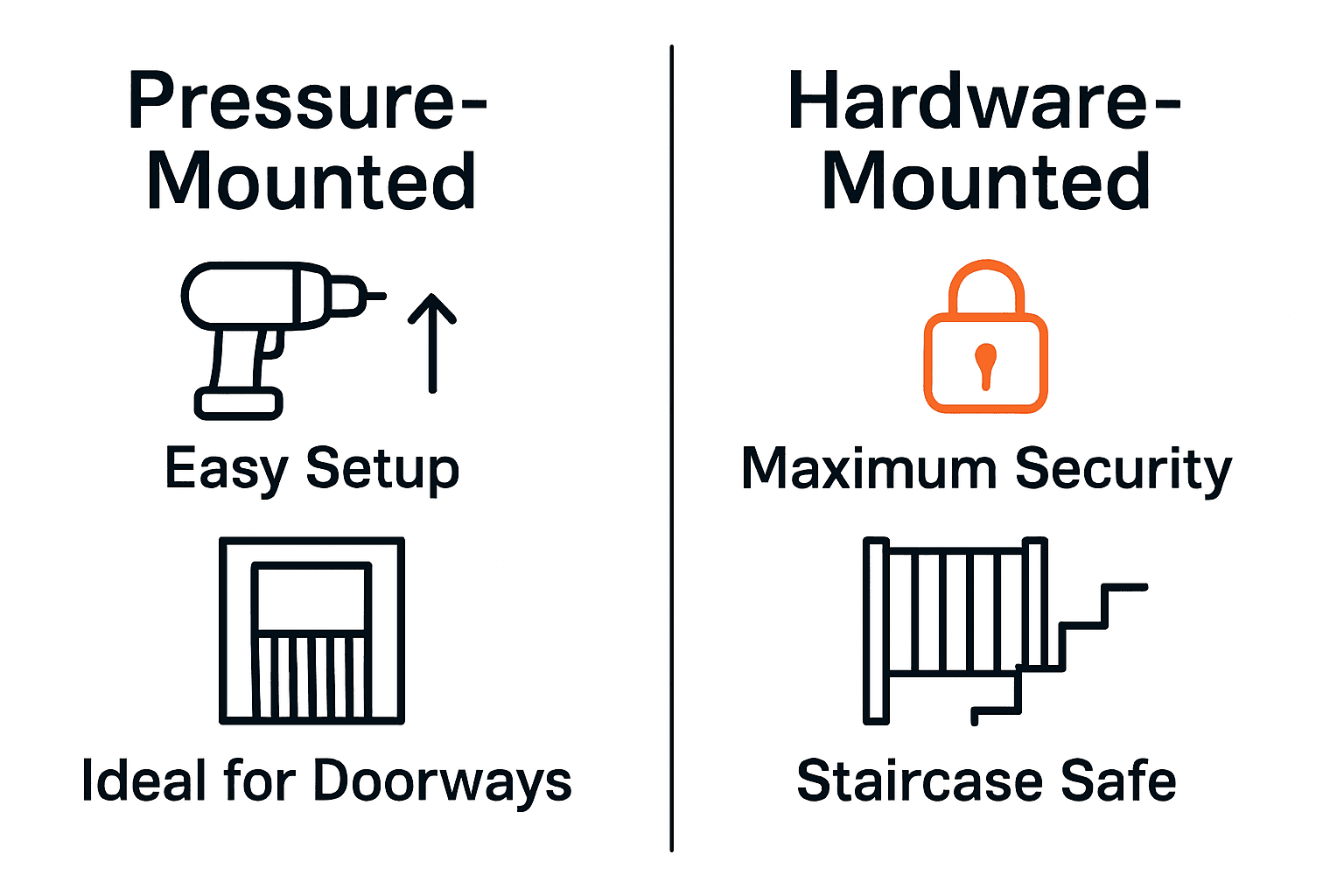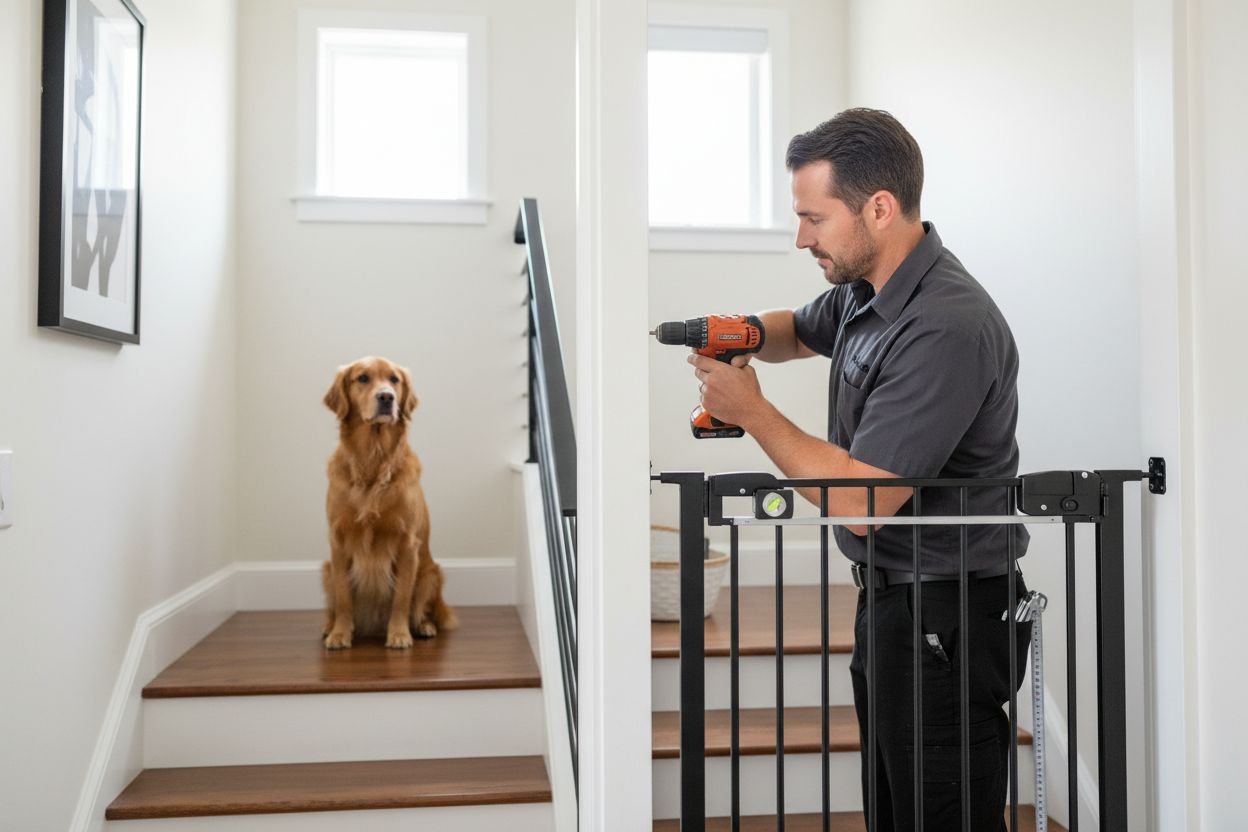
The Essential Guide to Safety Gates in Pet Homes

Did you know that over 67 percent of households in the United States own a pet? With so many furry companions in our homes, keeping them safe has become a top priority for families everywhere. Pets are naturally curious and often find their way into rooms that may pose risks. The right safety gate provides an easy way to create protected areas, helping owners avoid common hazards while enjoying more peace of mind at home.
Key Takeaways
| Point | Details |
|---|---|
| Safety Gates are Essential | Safety gates restrict pet movement, preventing access to hazardous areas and ensuring a safe environment for both pets and humans. |
| Choose the Right Type | Select between pressure-mounted for temporary solutions and hardware-mounted for permanent, high-risk areas to ensure maximum safety. |
| Install Properly | Proper installation is critical; regularly check stability and utilize appropriate mounting techniques to ensure effective performance. |
| Match Material to Needs | Choose gate materials based on your pet's behavior and household dynamics: metal for durability, wood for aesthetics, and plastic for lightweight needs. |
Defining Safety Gates for Pet Homes
A safety gate is a specialized barrier designed to restrict pet movement within a home while providing convenient access for human family members. Unlike traditional barriers, these innovative solutions offer controlled containment that allows pets and owners to navigate their shared living spaces safely and comfortably.
At their core, safety gates serve multiple critical functions for pet owners. They prevent pets from accessing potentially dangerous areas like kitchens with hot surfaces, staircases with fall risks, or rooms with fragile items. These gates create designated safe zones where pets can remain protected while giving owners peace of mind about their furry companions' security.
- Prevents unauthorized pet movement
- Creates controlled home environments
- Protects pets from potential household hazards
- Offers easy human passage with specialized opening mechanisms
Modern pet safety gates come in various materials and designs, ranging from pressure-mounted options for temporary use to hardware-mounted gates for permanent installation. Some feature walk-through panels with one-handed operation, while others include pet-sized cutouts or mesh designs that allow visual contact while maintaining physical separation. The goal remains consistent: providing a flexible, humane solution for managing pet movement without compromising home aesthetics or family dynamics.
Types of Safety Gates for Pets
Pet safety gates come in multiple configurations, each designed to address specific household needs and spatial challenges. The two primary types - pressure-mounted and hardware-mounted gates - represent distinct approaches to creating secure boundaries for pets within home environments.
Pressure-mounted gates are lightweight, versatile solutions ideal for temporary barriers between rooms or in doorways. These gates use tension springs or adjustable panels that press against wall surfaces, creating a secure fit without permanent installation. Pros include easy setup, portability, and minimal wall damage. However, they're less stable and not recommended for high-risk areas like staircases where a fall could cause serious injury.
Here's a comparison of pressure-mounted and hardware-mounted pet safety gates:
| Feature | Pressure-Mounted Gate | Hardware-Mounted Gate |
|---|---|---|
| Installation | Tool-free<br>Quick setup | Requires tools<br>Permanent |
| Surface impact | No wall damage | Small holes in wall |
| Stability | Moderate<br>Less secure | High<br>Maximum security |
| Best Locations | Doorways<br>Room transitions | Stairs<br>High-risk areas |
| Portability | Easy to move | Fixed position |
| Suitable for | Temporary use<br>Calm pets | Long-term<br>Active pets |
- Quick and tool-free installation
- Suitable for doorways and room transitions
- No drilling or permanent wall modifications
- Best for low-traffic or temporary barrier needs
Hardware-mounted gates represent the gold standard for pet safety, especially in high-risk zones. These gates are physically bolted into wall studs or door frames, providing maximum stability and preventing accidental dislodging. They're particularly crucial for staircases, preventing pets from potentially dangerous falls. While installation requires more effort and potentially creates small wall holes, the trade-off in safety is substantial. Families with active pets, young children, or multi-level homes will find hardware-mounted gates an indispensable safety investment.

Essential Features and Installation Tips
Pet safety gates are more than just physical barriers - they're sophisticated systems designed to protect your furry friends while maintaining home functionality. The most advanced gates feature intelligent design elements that go beyond simple obstruction, incorporating smart safety mechanisms that provide peace of mind for pet owners.
Critical gate features include auto-close and auto-lock systems, which automatically secure the gate after passage. These mechanisms typically incorporate spring-loaded hinges and audible lock indicators, ensuring the barrier remains intact even if someone forgets to manually close it. Additional sophisticated features like dual-lock systems and visual engagement indicators help prevent accidental openings that could compromise pet safety.
- Spring-loaded automatic closing mechanism
- Audible lock confirmation
- Dual-lock safety system
- Visual lock status indicators
- Tension adjustment capabilities
Installation requires careful consideration and precision. For pressure-mounted gates, use wall cups and tension indicators to ensure a secure fit. Critically, avoid placing these gates near stairs where stability becomes paramount. Hardware-mounted gates demand even more attention: use a stud finder to locate wall studs, mount brackets precisely, and follow manufacturer torque specifications. Positioning is key - for staircase gates, mount at least six inches from the top step to prevent potential falling hazards.
 Remember, proper installation transforms a simple gate from a basic barrier into a robust safety solution for your pets.
Remember, proper installation transforms a simple gate from a basic barrier into a robust safety solution for your pets.
Real-World Uses in Pet-Proofing Homes
Pet safety gates transform home environments by creating strategic barriers that protect both pets and living spaces. Different areas of the home require unique approaches to containment, making material selection and gate placement critical for effective pet-proofing. Understanding these nuanced requirements helps pet owners create safe, harmonious living environments.
In high-traffic zones like kitchens, metal gates provide the most robust solution. These gates withstand constant interaction, resist chewing, and maintain structural integrity even with active or larger pets. Metal gates excel in areas with potential hazards like hot surfaces, sharp objects, or fragile items. Their durability makes them ideal for preventing curious pets from accessing dangerous zones while maintaining visual transparency.
- Protect kitchen work areas
- Block access to dangerous household zones
- Prevent pets from interfering with cooking
- Create clear visual boundaries
- Maintain home aesthetic and functionality
Material considerations play a significant role in pet gate effectiveness. While metal offers maximum durability, wooden gates provide aesthetic appeal for design-conscious households. Plastic gates represent a lightweight, affordable option but may struggle with persistent chewers or high-energy pets. The key is matching gate material to your specific pet's behavior and home environment. A small, calm dog might do well with a decorative wooden gate, whereas a large, energetic breed would require a robust metal barrier. Strategic placement and material selection transform pet gates from simple barriers into sophisticated home management tools.
Common Mistakes and Risks to Avoid
Pet safety gates are only as effective as their proper installation and selection. Many well-intentioned pet owners unknowingly compromise their pets' safety by making critical errors during gate selection and placement, turning a protective measure into a potential hazard.
One of the most dangerous mistakes is using pressure-mounted gates in high-risk areas like staircases. These gates can unexpectedly loosen or dislodge, potentially causing serious falls or injuries. Equally risky is placing gates on hollow, uneven, or unstable surfaces without proper tension checks and wall cup usage. Pet owners must carefully assess surface integrity and consistently verify gate stability, paying close attention to tension mechanisms and mounting points.
- Never use pressure gates on stairs
- Always check mounting surface stability
- Perform regular tension and lock mechanism checks
- Match gate material to pet's size and energy level
- Inspect gates for wear and damage
Material selection presents another critical risk zone. Cheap or inappropriate gates can fail catastrophically under pet stress. Plastic gates may crack or break unexpectedly, wooden gates can splinter, and poorly constructed barriers might collapse under a pet's weight or persistent pushing. The consequences extend beyond potential property damage - inappropriate gates can cause physical injury to pets or create escape routes that compromise their safety. Investing in high-quality, purpose-designed gates from reputable manufacturers is not a luxury, but a fundamental responsibility for responsible pet ownership.
Find the Best Safety Gate for a Safer Pet Home
Have you ever worried about your pet slipping into dangerous areas or wondered if the gate you use is truly secure? The article highlighted real risks—from using the wrong type of gate on stairs to material choices that cannot withstand active pets. Choosing and installing the right safety gate is more than a convenience; it is about protecting your furry family members and avoiding common hazards. You deserve solutions that work for your unique home and pet needs.
Make your next step a confident one. Discover expert-reviewed guides, detailed comparison charts, and essential installation advice on baby safety gates for pets and homes. If you are unsure which type or material is best for your space, our main hub at https://babysafetygates.world is your trusted source. Do not wait until an accident or frustration happens—visit us now to make your home safer and your peace of mind permanent.
Frequently Asked Questions
What are safety gates for pets?
Safety gates for pets are specialized barriers designed to limit a pet's movement within a home while allowing convenient access for humans. They help protect pets from dangerous areas and create controlled environments.
What is the difference between pressure-mounted and hardware-mounted safety gates?
Pressure-mounted gates are lightweight and easy to install without tools, ideal for temporary use. Hardware-mounted gates are more stable, designed for permanent installation, and are best suited for high-risk areas like staircases.
How do I install a pet safety gate correctly?
To install a pet safety gate, ensure the mounting surface is stable. For pressure-mounted gates, use wall cups and check tension settings. For hardware-mounted gates, locate wall studs with a stud finder and follow installation instructions carefully to secure the gate properly.
What features should I look for in a pet safety gate?
Look for gates with auto-close and auto-lock systems, dual-lock mechanisms, and visual lock indicators. These features enhance safety by preventing accidental openings and ensuring the gate remains secured after passage.




